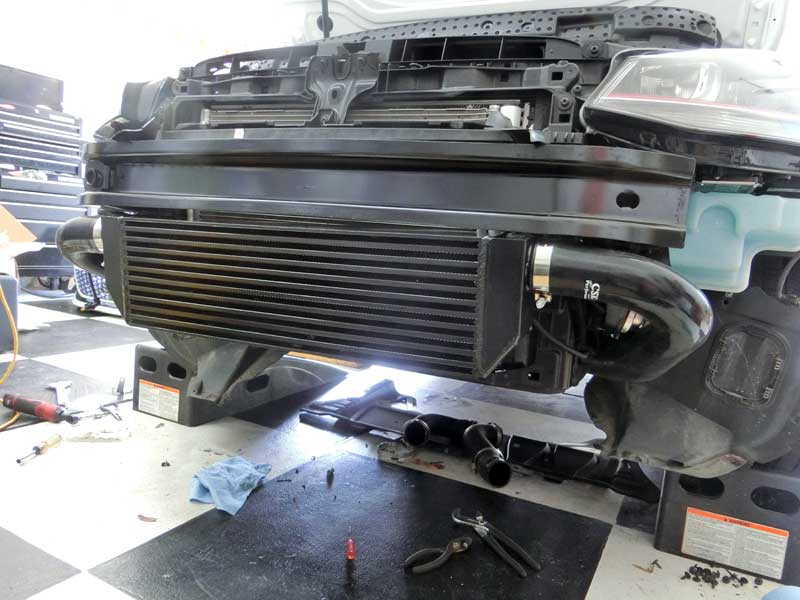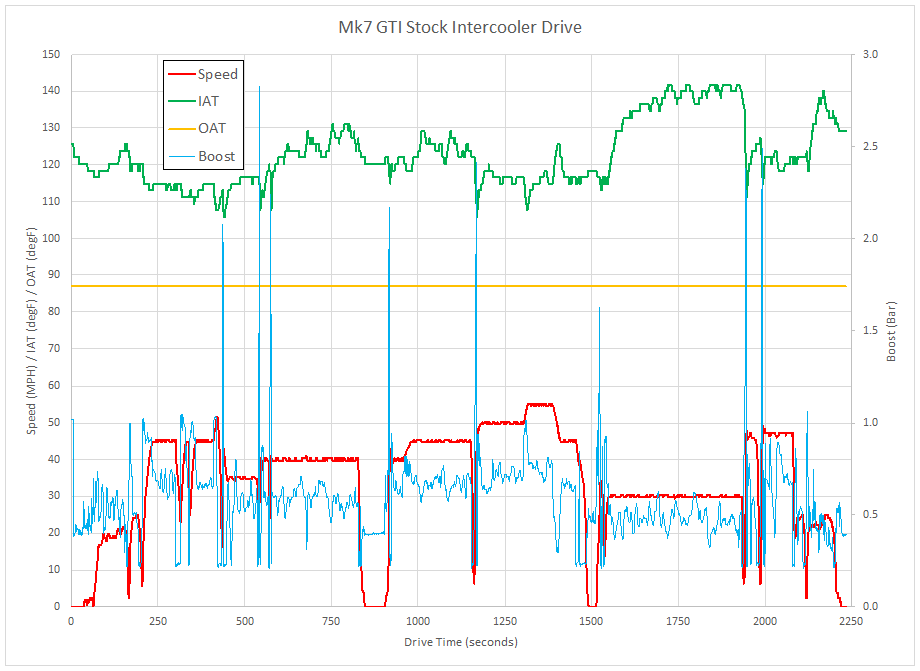With the additional of an eBay FMIC to the Mk7 GTI a drive was taken to record intake air temperature over a preselected course.


The results from taking the drive with the eBay FMIC are compared with the same drive made with just the Stock Mk7 GTI intercooler. The eBay Front Mount is installed in the “Twintercooler” configuration meaning it operates in parallel with the Stock GTI intercooler.
Results:
The stock intercooler drive is shown in the chart below:

The stock intercooler along with eBay FMIC drive results are below:

Overlaying the vehicle speed and intake air temperature curves produces the following composite chart:

Outside air temperature is omitted from the chart to reduce the amount of data shown and is noted in the chart title. Similar outside air temperature conditions were present for each drive.
Conclusion:
For the test route the differences in Intake Air Temperature between the Stock IC alone and the Stock IC with the addition of the eBay FMIC were minimal.
The car had been driven prior to the Stock IC test drive which explains the higher starting temperature.
During the final stretch of the drive where the vehicle speed slows to 30 mph the benefit of having the FMIC is evident as the IAT does not rise as rapidly as in the case of the Stock GTI IC alone. At speed of 40 mph and above the FMIC doesn’t appear to provide any benefit over the Stock IC alone.

I love what you are doing here. Your work on the TIP airflow has been remarkable and a huge benefit for me (I’ll be picking-up a BMS TIP soon) and for the VW modding community as a whole. However, I think your FMIC testing methodology might be flawed. It appears from your testing that much of the IAT benefits you expected were “Speed” based and not “Boost” based. It seems to me that the real test of a intercooler should be based on intake temps pre and post intercooler at a particular boost pressure. I noticed on both charts that the IATs dropped most when the boost was at/near peak. That would indicate where the ICs were performing at their best. In those instances the additional FMIC dropped the IATs to lower than the Stock alone (usually by around 10 degrees or more). The IATs were much closer when boost pressures were at a steady .5 to .75 bar (though the addition of the FMIC was always lower) which is what I would expect. Perhaps another run of both Stock and Stock + FMIC with extended times at full boost would be a better comparison of the overall effectiveness of both set-ups. Especially since I noticed you are now attempting to install the 1st-racinguk IC. Again, I think what you are doing is awesome, and I greatly appreciate for your efforts and the data you are posting.
Thanks for the feedback. My goal in driving the circuit course is to compare the intercoolers under conditions that are representative of how I operate the car. I’m interested in learning if there is a benefit to me when operating with an aftermarket IC, thus I am driving a route that is typical of my normal driving. Under these conditions I am only operating in boost for a short period of time, just long enough to get up to the speed of the road I am traveling on. The performance aspect that is more likely to show here is the efficiency of the core at lower flow rates of ambient air. Some cores are designed with dense fins on the ambient air side and as vehicle speed decreases the pressure differential across the core lowers to a point where not enough cooling air is passing through the core, and the IATs begin to rise. For a car that is driven around town and at generally slower speeds this could become a concern since most of the ICs seem to drop temperature about the same amount, give or take 5 to10 degrees. If the temperature that an IC reaches a stable temperature over ambient is appreciably higher than another, that could be a greater factor toward the IAT than the amount of charge air temperature drop. What you are suggesting is also a good test to conduct, for the time being I decided to look at the ICs from this perspective.